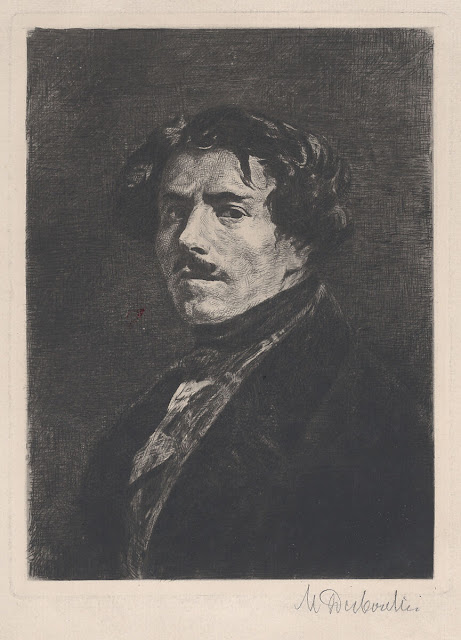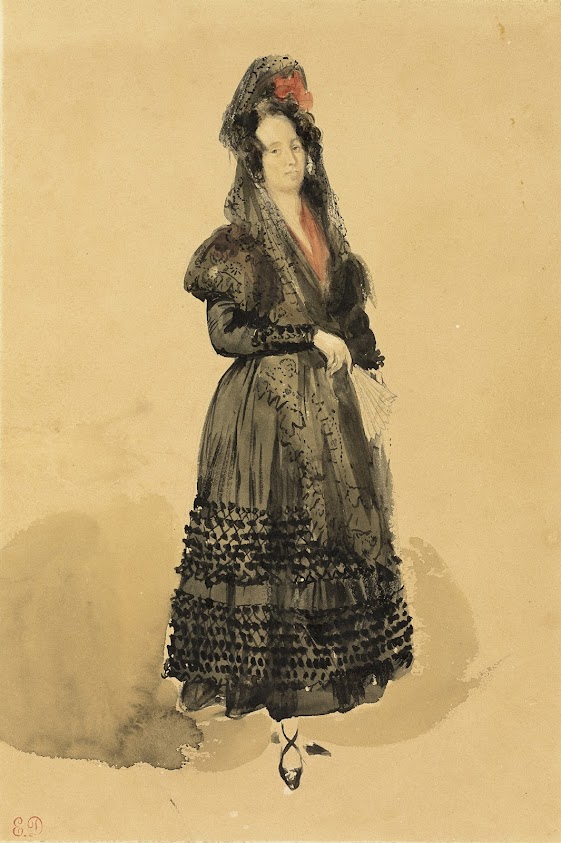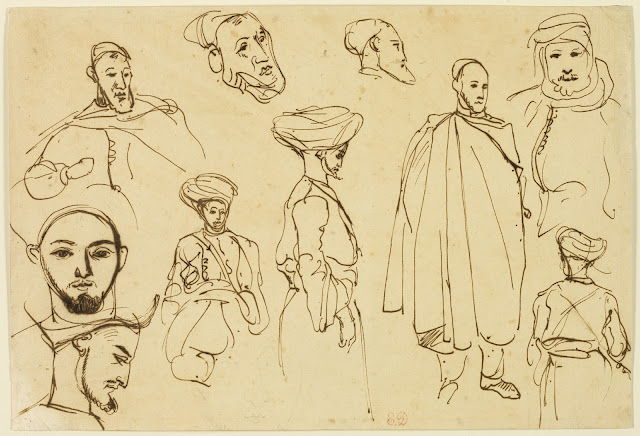 |
| Eugène Delacroix © Musée d’Orsay, Dist. RMN-Grand Palais / Alexis Brandt |
Poet and art critic Charles Baudelaire described his hero Eugène Delacroix as "a volcanic crater artistically concealed beneath bouquets of flowers." Beneath the surface of Delacroix's polished elegance and charm roiled turbulent interior emotions. In 1822 Delacroix took the Salon by storm. Although the French artistic establishment considered him a wild man and a rebel, the French government, bought his paintings and commissioned murals throughout Paris. Though Delacroix aimed to balance classicism and Romanticism, his art cenreed on a revolutionary idea born with the Romantics: that art should be created out of sincerity, that it should express the artist's true feelings and convictions. Educated firmly in the classics, Delacroix often depicted mythological subjects, themes encouraged by the reigning Neoclassical artists at the Académie des Beaux-Arts. But Delacroix's brilliant colors and passionate brushwork frightened them; their watchwords were "noble simplicity and calm grandeur." They barred him from academy membership until 1857, and even then he was prohibited from teaching in the École des Beaux-Arts. For those very reasons, he was an inspiration to the Impressionists and other young artists. Paul Cézanne once said, "We are all in Delacroix." Intensely private, Delacroix kept a journal that is renowned as a profoundly moving record of the artistic experience.
This is part 4 of of a 6-part series on the works of Eugène Delacroix:
%20etching;%20first%20state%20of%20four%2015.8%20x%2012%20cm%20The%20Metropolitan%20Museum%20of%20Art,%20New%20York.jpg) |
| 1833 Ecce Homo (Christ with the Reed) etching: first state of four 15.8 x 12 cm The Metropolitan Museum of Art, New York |
%20Philadelphia%20Museunm%20of%20Art,%20PA.jpg) |
| 1833 Muletiers de Tétuan lithograph on paper 19.4 x 26.7 cm (image) Philadelphia Museunm of Art, PA |
 |
| 1833 Portrait of Madame Frédéric Villot etching, second state 8.6 x 8.3 cm The Metropolitan Museum of Art, New York |
.jpg) |
| 1833 Strolling Players watercolour on paper 24.8 x 18.4 cm Los Angeles County Museum of Art (LACMA) |
%20Art%20Institute%20of%20Chicago,%20IL.jpg) |
| 1833 Study of a woman seen from the back etching in black on off-white wove paper 10.5 x 15.5 cm (image) Art Institute of Chicago, IL |
 |
| 1833 Women of Algiers graphite on paper 20.7 x 33.5 cm National Gallery of Art, Washington, DC |
%20The%20Metropolitan%20Museum%20of%20Art,%20New%20York.jpg) |
| 1833 Women of Algiers lithograph: second state of two 16 x 22 cm (image) The Metropolitan Museum of Art, New York |
%20Museum%20of%20Fine%20Arts,%20Boston,%20MA.jpg) |
| c1833 Arabes D'Oran etching on paper 14.5 x 19 cm (image) Museum of Fine Arts, Boston, MA |
 |
| c1833 Still Life with Dahlias oil on canvas 50 x 33 cm Philadelphia Museum of Art, PA |
 |
| 1834 Bacchus and a Tiger fresco 57 x 89 cm Musée National Eugène Delacroix ©RMN-grand Palais, Louvre Museum, Paris |
%20oil%20on%20canvas%2088.2%20x%20115.8%20Los%20Angeles%20County%20Museum%20of%20Art%20(LACMA).jpg) |
| before 1834 Henri IV Conferring the Regency upon Marie de' Medici (after Rubens) oil on canvas 88.2 x 115.8 Los Angeles County Museum of Art (LACMA) |
 |
| Henri IV Conferring the Regency upon Marie de' Medici detail |
 |
| Henri IV Conferring the Regency upon Marie de' Medici detail |
%20The%20Metropolitan%20Museum%20of%20Art,%20New%20York.jpg) |
| 1834 Collision of Moorish Horsemen etching on paper 26.2 x 18.4 cm (plate) The Metropolitan Museum of Art, New York |
 |
| 1834 Portrait of George Sand oil on canvas 26 x x 21.3 cm Musée National Eugène Delacroix ©RMN-grand Palais, Louvre Museum, Paris |
 |
| 1834 The Turkish Rider gouache and watercolour, with scraping, selectively gum-varnished, on cream wove paper 25.2 x 18.7 cm Art Institute of Chicago, IL |
,%20Paris..jpg) |
| 1834 Women of Algiers in their Apartment oil on canvas 180 x 229 cm © RMN - Grand Palais (Louvre museum), Paris |
%20The%20Metropolitan%20Museum%20of%20Art,%20New%20York.jpg) |
| 1834 Young Clifford finding the body of his father, from "L'Artiste" lithograph on paper 22.3 x 15.7 cm (image) The Metropolitan Museum of Art, New York |
1835-43 Hamlet
In 1834 Delacroix began a series of lithographs devoted to Hamlet, creating moody images that mirror the troubled psyche of the prince. Choosing key scenes and poetic passages, the artist's highly personal and dramatic images were unusual in France, where interest in Shakespeare developed only in the nineteenth century. Gihaut frères published the artist's thirteen-print set in 1843, with a second expanded edition of sixteen issued by Bertauts in 1864. Cooly received at first, the prints eventually were recognised as one of the artist's most significant achievements.
%20.jpg) |
| 1834 Hamlet and the Queen lithograph in black on off-white China paper 25.4 x 19.8 cm (image) |
.jpg) |
| 1834 Hamlet and the Queen lithograph in black on off-white China paper 26 x 17.9 cm (image) |
.webp) |
| 1834 Ophelia's Song lithograph in black on off-white China paper 25.8 x 20.7 cm (image) |
 |
| What ist ? A rat? lithograph in black on off-white China paper |
.jpg) |
| 1834-43 Hamlet and Ophelia lithograph in black on off-white China paper 24.2 x 19.8 cm (image) |
.jpg) |
| 1834-43 Polonius and Hamlet lithograph in black on off-white China paper 24.9 x 18.4 cm (image) |
.jpg) |
| 1835 Hamlet and the Body of Polonius lithograph in black on off-white China paper 25.6 x 17.8 cm (image) |
.jpg) |
| 1835 Hamlet Makes the Players Enact the Poisoning of His Father lithograph in black on off-white China paper 24.9 x 32.3 cm (image) |
.jpg) |
| 1835 Hamlet Pursuing His Father's Ghost lithograph in black on off-white China paper 25.9 x 20.3 cm (image) |
%20.jpg) |
| 1843 Hamlet and Guildenstern lithograph in black on off-white China paper 25.1 x 20.2 cm (image) |
.jpg) |
| 1843 Hamlet and Horatio with the Gravediggers lithograph in black on ivory China 28.4 x 21.2 cm (image) |
 |
| 1843 Hamlet and Laertes at the Tomb of Ophelia graphite on tracing paper, laid down 23.3 x 30.6 cm |
.jpg) |
| 1843 Hamlet and Laertes in Ophelia's Grave lithograph 28.5 x 19.4 cm (image) |
 |
| 1843 Hamlet and the Gravediggers black chalk, with touches of graphite, on cream laid paper 28.4 x 20.1 cm |
..jpg) |
| 1843 Hamlet attempts to slay the King lithograph in black on off-white China paper 25.4 x 18.1 cm (image) |
.jpg) |
| 1843 Ophelia's Death lithograph in black on white wove paper 15.8 x 25.7 cm (image) |
.jpg) |
| 1843 The Ghost on the Platform lithograph in black on off-white China paper 25.9 x 19.2 cm (image) |
.jpg) |
| 1846 Hamlet's Death lithograph in black on white China paper 29 x 20.2 cm (image) |
1849 Hamlet and His Mother
This painting depicts the moment in Shakespeare’s epic tragedy Hamlet in which the protagonist, who has been speaking privately with his mother, Queen Gertrude of Denmark, notices a figure behind the curtains of her closet. Immediately afterward, Hamlet will impale the hidden Polonius with his sword, and utter the memorable phrase "How now! A rat? Dead for a ducat, dead!" The composition is identical to a black and white lithograph Delacroix made for a portfolio devoted to the play, which was first published in 1843.
 |
| 1849 Hamlet and his Mother oil on canvas 27.3 x 18.1 cm The Metropolitan Museum of Art, New York |
 |
| c1834 Standing woman in Moroccan costume graphite and watercolour on wove paper 32.5 x 20.8 cm The Metropolitan Museum of Art, New York |
 |
| 1835 Lion and tortoise pen and iron gall ink with graphite on light blue moderately thick, smooth wove paper 19.8 x 26.1 cm The Walters Museum, Baltimore, MD |
1835 Madame Henri François Riesener
The Met note: Delacroix rarely portrayed anyone other than his closest family and friends. His affection for Madame Riesener, an aunt by marriage, is expressed through the frank tenderness of this portrait. She was once known for her beauty: some thirty years before the date of this portrait she served as a lady-in-waiting to empress Josephine, and having caught Napoleon’s eye, engaged in a brief liaison with him. After she died, Delacroix wrote to George Sand, "each of the beings necessary to our existence who disappears, takes away with him a whole world of feelings that no other relationship can revive."
%20oil%20on%20canvas%2074.3%20x%2060.3%20cm%20The%20Metropolitan%20Museum%20of%20Art,%20New%20York*.jpg) |
| 1835 Madame Henri François Riesener (Félicité Longrois, 1786–1847) oil on canvas 74.3 x 60.3 cm The Metropolitan Museum of Art, New York |
 |
| c1835 Male Nude Posing for figures in the Frieze of War graphite on laid paper 19.6 x 29.1 cm National Gallery of Art, Washington, DC |
 |
| 1838 Christopher Columbus and his son at La Rábida oil on canvas 90.3 x 118 cm National Gallery of Art, Washington, DC |
 |
| 1849 Arab Horseman at the gallop graphite on tracing paper 32 x 25.7 cm National Gallery of Art, Washington, DC |
 |
| 1849 Basket of Flowers and Fruit oil on canvas 108.3 x 143.2 cm Philadelphia Museum of Art, PA |
 |
| 1849 Basket of Flowers and Fruit detail |




*.jpg)






,%20Paris.jpg)







.jpg)

.jpg)











%20The%20Metropolitan%20Museum%20of%20Art,%20New%20York.jpg)

.jpg)
.jpg)

.jpg)
.jpg)

%20Art%20Institute%20of%20Chicago,%20IL.jpg)
%20The%20Metropolitan%20Museum%20of%20Art,%20New%20York.jpg)



.jpg)

%20The%20Metropolitan%20Museum%20of%20Art,%20New%20York.jpg)
.jpg)